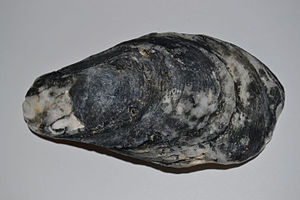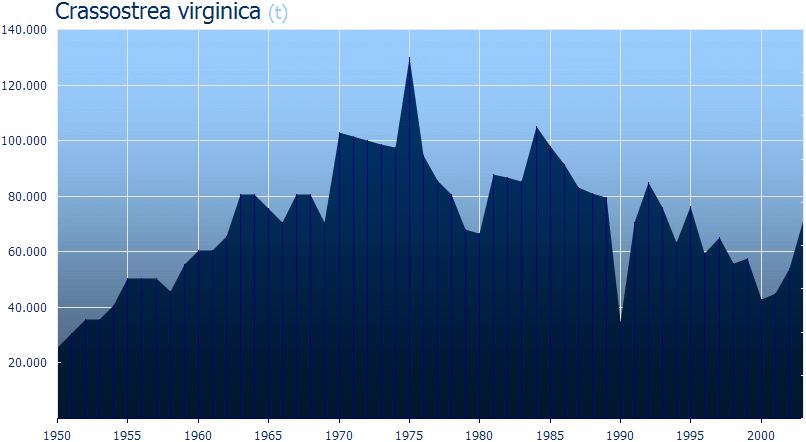American oyster
| American oyster | ||||||||||||
|---|---|---|---|---|---|---|---|---|---|---|---|---|

American oyster ( Crassostrea virginica ) |
||||||||||||
| Systematics | ||||||||||||
|
||||||||||||
| Scientific name | ||||||||||||
| Crassostrea virginica | ||||||||||||
| Gmelin , 1791 |
The American oyster ( Crassostrea virginica ) is the second most important oyster species with a world market share of 5.1 percent (2003). It's called Huître (creuse) américaine in French and American (cupped) oyster in English .
Appearance
American oysters are mostly oval shaped. The shell is hard but not very angular, while the lower shell is relatively flat. The color is mostly gray, occasionally also brownish. The oyster is medium in size and can grow up to 38 cm long and 1.3 kg, the commercial size is 8-18 cm.
distribution
This species of oyster is found on the east coast of North America , from the mouth of the Saint Lawrence River in Canada to the Gulf of Mexico and on to Panama . An important place of origin is the Chesapeake Bay (USA).
Way of life
The American oyster lives in coastal waters at depths of 0.5 to 75 meters. It needs a hard surface, if necessary it will also settle on older oysters. It prefers bays and mouths of rivers where the salinity of the water is between 5 ‰ and 30 ‰.
Commercial Use and Exposure
The American oyster is rarely grown in aquaculture ; it is the only type of oyster that is fished from the seabed, preferably (70%) with scrapers . In some regions of North America suffers breeding of the American oyster much under attack also known as oyster drill snail designated urosalpinx cinerea , which can wipe out an entire population. In these areas, the young oysters are raised in sheltered tanks and only released into the sea when they are two years old. The shells are then thick enough to withstand the oyster borer.
The world's largest producer is the USA with 184,000 tons per year, that is 77 percent of world production. Many oysters are fished here in Chesapeake Bay . This is followed by Mexico (10%) and Canada (3%). The oyster suffers from overfishing and water pollution and is currently on the decline.
Culinary
American oysters are often processed as " meat oysters " and filled into cans. In the USA they are also consumed raw ("slurped"), although they are not infrequently "refined" with ketchup and other spicy sauces beforehand. Well-known trade names are "Bluepoint" ( Connecticut ), "Wellfleet" and "Cotuit" ( Massachusetts ), "Patuxent" ( Maryland ), "Apalachicola" and "Indian River" ( Florida ), " Breton Sound " and "Black Bay" ( Louisiana ) and "Malpeque" (Prince Edward Islands, Canada ). The oyster species is not in demand outside of North America.
World annual production
- Annual production in tons (source: FAO / FIGIS)


